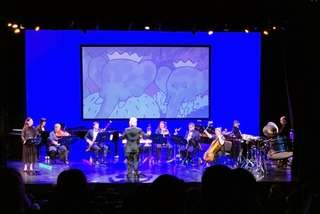|
Back
Elephants Meet an Orchestra New York
Florence Gould Hall
11/02/2018 - & November 3, 2018
Raphael Mostel: The Travels of Babar (U.S. Premiere)
Leah Pisar (Narrator, French and English)
Tyler Neidermayer (Clarinet), Erik Höltje (Bassoon), Thomas Hoyt (Cornet), William Lang (Trombone), Aurora Manuel (Viola), Jillian Annie Blythe (Cello), Taka Kigawa (Piano), Barry Centanni (Percussion), Neal Goren (Conductor)
Watercolors from Bibliothèque Nationale de France; Slideshow directed by the composer; Michael Mazzola (Lighting Design)

King and Queen B&C. Elephant (background), N. Goren & Ensemble (Foreground) (© JC Agid)
“Only children and animals understand my music.”
Igor Stravinsky
One doubts that Stravinsky was being serious in that quote. But composer Raphael Mostel obviously had a good starting point in this hour-look wondrous piece for narrator, orchestra and the timeless watercolors of Jean de Brunhoff. For his characters were all animals (elephants, of course, and rhinos, birds, monkeys and a lazy bear) and his audience this afternoon were mainly children.
Kids as young as five years old. And they were (in Shakespeare’s words) the “onlie begetters” of Babar. I have no idea whether kids read Babar books today, but it was the very first book read by my companion, and she almost cried as those watercolors of Babar slid by on the screen behind the orchestra in modestly dazzling fashion.
Whatever the stories of the original Babar, those paintings (one dare not call them illustrations) could only be compared to the sketches of The Good Soldier Svejk, also written in the 1920’s. The latter, though, were in black and white. M. de Brunhoff had a pastel delicacy, a delicious Monet-Impressionist style for his backgrounds of a 1920’s Parisian port. As for the faces of the elephants...
Well, I have worked with elephants in Thailand, and have vast admiration for their talents. But the faces of Babar, his wife Celeste (seen above), the mischievous Arthur and a sagacious Old Elephant, as well as the herd...they are faces which transcend naturalism, faces which could have been on the cusp of Disney-creatures, but in their silence, they have an ethereal (if not Platonic) beau idéal of Elephant itself.
Far more important was that those pictures were irresistible to the children–and us grownups–who crowded into Florence Gould Hall, who let out nary a squeak, a cry, a yawn, a squall. Whether the kids were mesmerized by the pictures or the story or the music, it doesn’t matter. It was their theater-piece.

L. Pisar/R. Mostel (© Samuel A. Dog)
How did Mr. Mostel handle the music? The only resemblance would have been Peter and the Wolf, of course. Prokofiev laid that out a shortcut, that each creature had its own tune, which could be pulled out like a leitmotifas the story continued.
Mr. Mostel used no shortcuts. Yes, the narrator, Leah Pisar, showed the audience each instrument of the truncated orchestra before the story. (And conductor Neal Goren had several stars here including pianist Taka Kigawa.) After that introduction, Mr. Mostel took several paths through the forest, the air, a ship, a circus, and even a war.
The only ongoing theme was a cornet tattoo starting the work, going up in fifths. That military salute (for the Royal Couple going on a honeymoon) was used throughout the hour-long show. But Mr. Mostel, unlike Prokofiev, varied eras and styles in a happy bewildering stew.
He gave us some rippling Saint-Saëns piano rippling for sleep, he offered a cello solo by Jillian Annie Blythe that could have come from Penderecki. In one section at the beginning, the instruments played a Conservatory-study of Bach, with a series of canons and fughettas, at other times, the instruments gave an musicanthromorphical imitation of rhinos (bassoon and trombone of course). At another time, in preparing for war, he allowed the orchestra to go down the scales, all in different rhythms. And naturally he couldn’t resist using punning lovely celeste solo to picture Babar’s Queen Celeste.
That description is not important. To the kids and their parents and grandparents, the music was the background for the animated slide show of the original Jean de Brunhoff paintings and the splendid story-telling of Ms. Pisar. And those kids were obviously the essential audience.
They didn’t use words like “deft” or “charming” for Mr. Mostel’s music. Instead, they were gripped by two elephants flying in a balloon-van, landing on an island, being attacked by cannibals (not, happily, seen, but pictured by their shields), and by a cartoon version of a war.
That Raphael Mostel gave them the sounds–funny sounds, exciting sounds, puzzling atonal sounds, silly sounds–was icing on a delicious cake. And obviously they (and, yes, we) were happy to eat it up.
Harry Rolnick
|